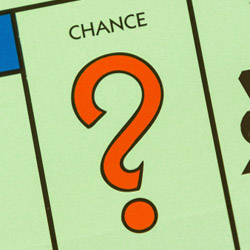
The best illustration of this is the story of Mr and Mrs Huntrodds, the couple who inspired the day. David Spiegelhalter came across the story while on holiday in Whitby, North Yorkshire. Francis and Mary Huntrodds were both born on the same day – September 19th 1600 – and were later married on their birthday and then sadly died on their 80th birthday in 1680.
The inscription that inspired Huntrodds’ Day

The Huntrodds had three extraordinary coincidences in their life events. But what are the odds of a couple sharing a birthday? Timandra explains the likelihood like this:
'A married person has a 1 in 365.25 chance (including leap years) of sharing their birthday with their partner. With approximately 11.6 million married couples in the UK, around 31,000 married couples in the UK would share a birthday.'
Over 30,000 couples isn’t very unique sounding, how about couples who were born on the same day like Mr and Mrs Huntrodds?
'The commonest age gap between British spouses is one year. Two years is the average (mean), but nearly 1 in 10 UK marriages are between people born in the same year. So 3,000 or so UK married couples would share one birthday cake, with the same number of candles.'
A more modern husband and wife story of coincidence came to light a few years ago when Mr and Mrs Pulsford of Pagham, West Sussex celebrated their 80th birthday. Again they were both born on the same day of the same year but also celebrated their eightieth birthday on 08/08/08. Or Mr and Mrs Wheeler, who discovered a childhood photo of them both playing on the same sandy beach – 11 years before they first met as adults.
Everybody loves quirky coincidences and extraordinary events, even statisticians. The reason statisticians love them is that it gives them the opportunity to employ their knowledge and techniques to try and work out a logical explanation for why events that seem amazing and unlikely keep happening.
David Hand has devoted a whole book to the subject called, The Improbability Principle, released earlier this year. In the book he investigates instances like the American author who, while browsing bookshops in Paris, discovers a book she was the previous owner of as a child. Or the man who got struck by lightning seven times in his lifetime. In the book, David explains why these astounding events happen through a set of five laws based on the mathematics of probability.
However, the organisers of Huntrodds’ Day don’t want our wonder of chance happenings to be dampened by the statistical explanations. Instead, for one day of the year they want us to celebrate and talk about them. Then the statisticians can worry about explaining them for the other 364 days.
The organisers are encouraging everyone to throw a Huntrodds' Party. The rules are simple – you must have 23 people in attendance, as this is the number needed for a more than 50% chance that two will share a birthday. Also, conversation has to be aimed at discovering coincidences among the guests (which basically gives attendees license to be nosey about each other).
David, Michael and Timandra are hosting their own Huntrodds’ Day event at the Artillery Arms on Bunhill Row in London (tickets are still available), next door to the final resting place of Thomas Bayes, the godfather of probability.



